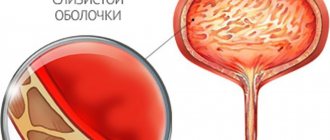Reiter's disease is named after the German physician Hans Reiter, who in 1916 described the clinical picture of a strange illness that included 3 symptoms: urethritis, arthritis and conjunctivitis.
disease or syndrome is a fairly rare disease that has become widespread due to the intensification of international tourism and, as a consequence, an increase in the risk of infectious diseases, including sexually transmitted diseases. This is a complex disease in which the organs of the genitourinary system, joints and eyes are simultaneously or sequentially affected. This disease is primarily the responsibility of a rheumatologist, but also of related specialists - urologists, gynecologists and ophthalmologists.
1
Consultation with a urologist for Reiter's disease
2 Consultation with a gynecologist for Reiter’s disease
3 Consultation with an ophthalmologist for Reiter’s disease
Causes of the disease
According to statistics, this syndrome most often affects representatives of the stronger sex; Reiter's disease in men (mostly aged 20-40 years) occurs in 80% of cases. Reiter's disease develops much less frequently in women; in isolated cases, children become infected.
It is assumed that one of the main factors of the disease is sexually transmitted infections. Most often, the causative agent is chlamydia, a microorganism 250-300 nm in size that can exist in the human body for a long time. In a life-threatening situation for the microorganism, chlamydia can transform into the L-form, which is more resistant to external influences and has the ability to be parasitized for a long time. All this contributes to the chronic course of the disease.
Reiter's disease can also be preceded by an acute intestinal infection, such as salmonellosis or dysentery. There are known cases of Reiter's disease caused by pathogenic flora that enters the human body through food intake or the respiratory route.
Hereditary predisposition plays a major role in the development of Reiter's syndrome. Improper immune activity is inherited from parents. Under appropriate, unfavorable conditions, the immune system begins to direct its forces to the cells of its own body.
In this regard, cases of the development of the disease due to sexually transmitted infection and after the patient has suffered infectious enterocolitis are usually separated.
General clinical recommendations
In the acute and subacute course of ReA, after a course of treatment, the patient should be under the supervision of a rheumatologist for six months with clinical and laboratory monitoring every 3 months.
In the chronic course of the disease, dispensary observation is longer with the prescription of courses of anti-relapse therapy until a state of stable remission appears.
After an illness, it is recommended to avoid heavy physical activity and strength sports. Swimming is a good way to restore joint function.
Persons with a genetic predisposition (presence of the HLA-B27 antigen) to reactive arthritis are recommended to have one proven sexual partner.
We combine proven techniques of the East and innovative methods of Western medicine.
Read more about our unique method of treating arthritis
What happens during Reiter's disease?
As a result of sexual infection in the genitourinary organs (urethra, prostate, cervical canal of the uterus), a focus of chronic inflammation is formed, which acts as a trigger for further inflammation in the joint tissues or organ of vision.
After some time, a cross-immune reaction appears, the severity of which determines the nature of the course of the disease.
There are 2 stages of the disease: the first is infectious, characterized by corresponding signs of damage to the genitourinary or gastrointestinal tract. The second is immunopathological, accompanied by the development of immune-mediated pathology with damage to the joints and conjunctiva of the eye.
Symptoms of Reiter's disease
Symptoms of Reiter's disease have a number of features:
- The period from the moment of infection to the moment of manifestation of the disease (incubation period) is 1-2 weeks;
- The onset of the disease is characterized by the appearance of signs of urethritis (pain when urinating, changes in urine, which are confirmed by laboratory tests).
- After a few days, conjunctivitis may begin (the patient experiences eye irritation, a feeling of sand, and the eyes become red).
- After some time (from 2 weeks to several months), large joints, usually knees or ankles, begin to hurt. Then the inflammation rises, and later the joints of the hands begin to ache. In this case, the joint enlarges, swells, and the skin around it becomes swollen.
- During the illness, periods of exacerbation and remission may alternate.
Cases of asymptomatic development of urethritis, when the appearance of conjunctivitis and arthritis seem unrelated, require special competence of doctors.
Only experienced and qualified specialists, such as rheumatologists at MedicCity, can recognize a hidden threat to the body and prescribe adequate treatment.
1 General blood test
2 X-ray of joints
3 Diagnosis of Reiter's disease
How dangerous is the disease?
The picture of the advanced stage of Reiter's disease looks very sad: pain and itching in the urethra, discharge from the urethra, pain in the knee, ankle, interphalangeal joints, inflammation of the mucous membrane of the eyes.
Inflammation of the Achilles tendon and severe pain in the heels often occur.
The development of balanoposthitis is possible.
In the acute period of the disease, keratoderma (mainly on the feet and palms) and psoriasis-like manifestations on the skin and nails often occur.
Lymphadenitis (usually inguinal glands), cardiac arrhythmias and conduction disturbances due to myocardial damage, and pericarditis may occur.
Kidney damage (glomerulonephritis, pyelonephritis, etc.) is common.
Possible localization of inflammation
In intestinal and urogenital forms of reactive arthritis, the joints of the lower extremities are most often affected. In the nasopharyngeal form - the joints of the upper extremities and the temporomandibular joint.
Arthritis of the lower extremities
Affection of the lower extremities predominantly begins with the big toes and moves upward (staircase sign), affecting the overlying joints asymmetrically. In reactive arthritis, one to five joints become inflamed:
- interphalangeal toes; Most often the first toe is affected, it swells and turns red - the “sausage toe” symptom;
- ankles with damage to surrounding tissues; Particularly characteristic is damage to the tendons and ligaments in the heel area with the formation of loose heel spurs, which causes constant pain that intensifies when walking and stepping on the heel;
- knee – this location is characterized by the formation of a large amount of exudate (inflammatory fluid in the joint), which leads to the formation of popliteal cysts; rupture of cysts leads to the development of thrombophlebitis and impaired venous circulation;
- hip – rarely affected, occurs in the form of moderate joint pain.
Chondroprotectors: what are they, how to choose, how effective are they?
Joint pain at rest
Arthritis of the upper extremities
Localization of reactive arthritis in the joints of the upper extremities is much less common. This mainly occurs in diseases of the nasopharynx and dental infectious and inflammatory processes.
The most common joints affected by ReA are:
- elbow - the elbow swells, turns red, becomes painful, the arm has difficulty bending and unbending;
- wrist with damage to the ligaments and tendons of the hand - pain in the joint is transmitted to the hand; severe pain does not allow you to squeeze and unclench your hand or hold objects in it;
- shoulder – rarely affected, characterized by swelling and pain.
Temporomandibular arthritis
Reactive arthritis affects the joints of the lower and upper extremities, temporomandibular joints
Triggers include infections of the nasopharynx, ear and mouth. Characterized by slight swelling, redness and swelling in the area of development of reactive arthritis. When opening the mouth, there is a slight asymmetry; the chewing process may be disrupted and become painful. The disease occurs acutely or subacutely, is well treated, and the prognosis is favorable.
Diagnosis of Reiter's disease
The clinical diagnosis is not difficult to predict if the characteristic symptoms of Reiter's disease are present. However, laboratory diagnostics are used to confirm the diagnosis:
- an increase in ESR indicates inflammation in the body;
- an increase in white blood cells indicates a bacterial infection;
- a clinical urine test can reveal urethritis, with the appearance of leukocytes;
- the presence of chlamydia is confirmed using polymerase chain reaction (PCR);
- Thanks to radiography and ultrasound examination of joints, it is possible to determine the degree of structural changes in the joints.
Benefits of medical
We are chosen for:
- selection of an individual treatment program for each patient (we make a thorough diagnosis and analyze its results);
- a team of competent and experienced specialists (doctors regularly expand their knowledge and improve the level of their skills);
- quality guarantee (we do not fight the symptoms, but eliminate the root of the problem);
- discounts on treatment, prevention and diagnostics (holders of Alfa-Bank and Cosmopolitan - VISA cards - 10%, holders of individual cards - services at reduced prices and participation in the bonus program);
- extensive experience (over 14 years of existence we have received many grateful reviews from satisfied patients);
- comfortable rehabilitation (the medical center has a therapeutic department, as well as a SPA center for a pleasant recovery).
Ask questions about Reiter's syndrome by phone in St. Petersburg +7!
All rights reserved by copyright law. No part of the contents of the site may be used, reproduced, transmitted by any electronic, copying or other means without the prior written permission of the copyright owner.
Treatment of Reiter's disease
Treatment of the disease is complex, the following drugs are used:
- broad-spectrum antibiotics;
- anti-inflammatory drugs (diclofenac, ortofen, etc.); if there is no effect, the doctor may prescribe hormonal anti-inflammatory drugs.
- painkillers to reduce joint pain;
- eye drops;
Therapeutic gymnastics can also be used to restore joint mobility.
A patient with Reiter's disease may require complex treatment from various specialists, using modern drugs, the latest diagnostic and therapeutic medical equipment. The MedikCity Clinic is a multidisciplinary clinic that provides medical services in 30 areas and has its own diagnostic center. We know how to treat Reiter's disease and other rheumatological diseases.
FAQ
Is reactive arthritis contagious?
No. But the urogenital infection that caused it can persist for a long time and be contagious.
Are there any peculiarities of the course, diagnosis, treatment in children?
In children, ReA is more acute and rarely becomes chronic.
What prognosis do doctors usually give?
The prognosis for reactive arthritis is favorable; in most cases, complete recovery occurs. But if left untreated, it becomes chronic with a long course and constant pain in the joints.
Reactive arthritis is a complex, incompletely studied infectious-allergic disease that mainly affects genetically predisposed people and requires timely and adequate treatment. It's not worth running.
But if you were unable to seek medical help in time, do not despair, modern technologies make it possible to provide assistance and relieve pain at any stage of the disease. The Paramita clinic (Moscow) will always help you.
Literature:
- Agababova ER, Bunchuk NV, Shubin SV, etc. Criteria for the diagnosis of reactive arthritis (draft). Scientific and Practical Rheumatology 2003;(3):82–3.
- Kovalev YN, Ilyin NI. Reiter's disease. Chelyabinsk: Option-book; 1993. 240 p.
- Zeidler H, Hudson AP. New insights into Chlamydia and arthritis. Promise of a cure? Ann Rheum Dis. 2014;73:637–44. doi:1136/annrheumdis-2013-204110.
- Ford D.K. Natural history of arthritis following venereal urethritis. Ann Rheum Dis. 1953;12(3):177–97. doi: 10.1136/ard.12.3.177.
Themes
Arthritis, Joints, Pain, Treatment without surgery Date of publication: 10/13/2020 Date of update: 12/14/2020
Reader rating
Rating: 5 / 5 (2)











